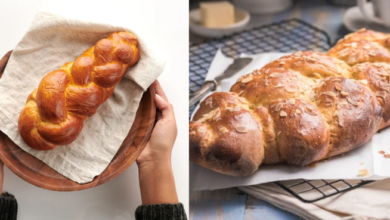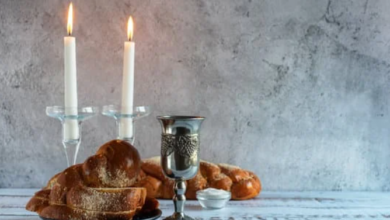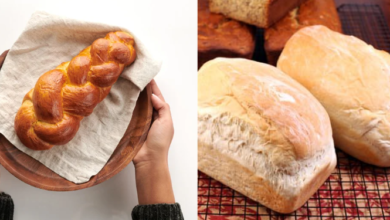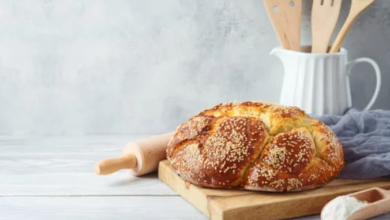Challah Vs. Hawaiian Bread: How Do They Compare?
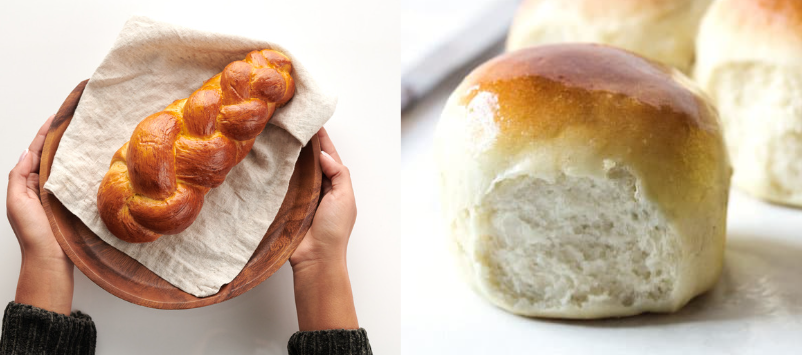
What To Know
- Challah is a Jewish bread with a long history, while Hawaiian bread is a modern creation.
- If you prefer a traditional Jewish bread with a slightly sweet flavor and soft, chewy texture, challah is an excellent option.
- If you are looking for a sweeter, fluffier bread with a hint of pineapple flavor, Hawaiian bread is the perfect choice.
The world of bread is vast and diverse, with countless varieties to satisfy every palate. Among the most beloved and iconic are challah and Hawaiian bread, two distinct creations that have captured the hearts and taste buds of bread enthusiasts worldwide. In this blog post, we will delve into the fascinating world of challah vs Hawaiian bread, exploring their unique characteristics, similarities, and differences.
Origin and History
Challah
Challah is a Jewish bread with a rich history dating back thousands of years. Its origins can be traced to the biblical era, where it was mentioned in the Torah as a special bread offered during Shabbat and holidays. Traditionally, challah is braided into intricate patterns, symbolizing the unity and interconnectedness of the Jewish community.
Hawaiian Bread
Hawaiian bread, also known as pineapple bread, is a relatively modern creation, originating in the early 20th century in Hawaii. It is believed to have been inspired by Portuguese sweet bread brought to the islands by immigrants. Hawaiian bread is characterized by its soft, fluffy texture and sweet, slightly tangy flavor.
Ingredients and Nutrition
Challah
Challah is typically made with a mixture of white flour, water, yeast, sugar, salt, and eggs. It may also include honey or milk for added sweetness and richness. Despite its egg content, challah is generally considered a lean bread with a relatively low fat content.
Hawaiian Bread
Hawaiian bread, on the other hand, contains more sugar and fat than challah. It is made with a combination of white flour, water, yeast, sugar, butter, milk, and often pineapple juice or puree. The pineapple gives Hawaiian bread its characteristic sweet and tangy flavor.
Texture and Taste
Challah
Challah is known for its soft, slightly chewy texture and slightly sweet flavor. The egg wash applied before baking gives it a golden-brown crust. The braided shape creates pockets of air, resulting in a light and airy crumb.
Hawaiian Bread
Hawaiian bread has an incredibly soft and fluffy texture that almost melts in your mouth. Its sweetness and tanginess are balanced by a subtle hint of pineapple flavor. The crust is soft and slightly crispy, providing a delightful contrast to the tender interior.
Uses and Occasions
Challah
Challah is primarily used as a ceremonial bread in Jewish households. It is often served on Shabbat and holidays, symbolizing blessing and abundance. It can also be enjoyed as a regular bread or used in sandwiches and other dishes.
Hawaiian Bread
Hawaiian bread is a versatile bread that can be used in a variety of ways. It is commonly served as a breakfast or snack bread, toasted or plain. It can also be used in French toast, bread pudding, or as a side dish with grilled meats or seafood.
Similarities and Differences
Similarities
- Both challah and Hawaiian bread are soft and fluffy breads.
- They are both made with white flour and yeast.
- They can both be used in a variety of ways, including as breakfast bread, sandwich bread, or side dish.
Differences
- Challah is a Jewish bread with a long history, while Hawaiian bread is a modern creation.
- Challah is typically braided, while Hawaiian bread is not.
- Challah has a slightly sweet flavor, while Hawaiian bread has a more pronounced sweet and tangy flavor.
- Challah is leaner than Hawaiian bread, with less sugar and fat.
Which Bread is Right for You?
The choice between challah and Hawaiian bread ultimately depends on your personal preferences and dietary needs. If you prefer a traditional Jewish bread with a slightly sweet flavor and soft, chewy texture, challah is an excellent option. If you are looking for a sweeter, fluffier bread with a hint of pineapple flavor, Hawaiian bread is the perfect choice.
A Culinary Odyssey: Exploring Variations
Challah Variations
Traditional challah is just the tip of the iceberg when it comes to this versatile bread. Variations include:
- Egg challah: Richer and more flavorful with a higher egg content.
- Honey challah: Sweetened with honey for an extra touch of sweetness.
- Whole wheat challah: Healthier and more nutritious with whole wheat flour.
Hawaiian Bread Variations
Hawaiian bread also has its share of variations, including:
- Lilikoi bread: Infused with the tangy flavor of passion fruit.
- Guava bread: Sweetened with guava puree for a tropical twist.
- Coconut bread: Topped with shredded coconut for a crunchy and flavorful addition.
Summary: A Bread for Every Occasion
Whether you are celebrating a special occasion or simply enjoying a delicious breakfast, challah and Hawaiian bread offer a unique and unforgettable culinary experience. Their distinct flavors, textures, and origins make them versatile and beloved additions to any bread lover‘s repertoire. From the traditional braids of challah to the fluffy sweetness of Hawaiian bread, there is a perfect bread out there for every taste and occasion.
Information You Need to Know
1. Can challah be made without eggs?
Yes, challah can be made without eggs. However, the eggs contribute to its richness and flavor.
2. Is Hawaiian bread vegan?
Traditional Hawaiian bread is not vegan as it contains butter and milk. However, vegan versions can be made using plant-based milk and butter.
3. How long does challah last?
Challah can be stored at room temperature for 2-3 days. It can also be frozen for up to 3 months.
4. How do I reheat Hawaiian bread?
Hawaiian bread can be reheated in the oven at 350°F (175°C) for 5-10 minutes, or in the microwave for 30-60 seconds.
5. Can I use challah for French toast?
Yes, challah makes excellent French toast due to its soft and slightly chewy texture.
